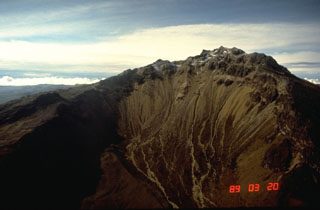Report on Cumbal (Colombia) — 11 July-17 July 2012
Smithsonian Institution / US Geological Survey
Weekly Volcanic Activity Report, 11 July-17 July 2012
Managing Editor: Sally Sennert.
Please cite this report as:
Global Volcanism Program, 2012. Report on Cumbal (Colombia) (Sennert, S, ed.). Weekly Volcanic Activity Report, 11 July-17 July 2012. Smithsonian Institution and US Geological Survey.
Cumbal
Colombia
0.95°N, 77.87°W; summit elev. 4764 m
All times are local (unless otherwise noted)
According to INGEOMINAS, a 10 July report from the Observatorio de Pasto noted that during recent months seismic swarms at Cumbal had been detected. Steam plumes from fumarolic fields were common. Nearby residents reported increases in gas emissions and seismicity, as well as possible noises. The Alert Level was increased to III (Yellow; "changes in the behavior of volcanic activity").
Geological Summary. Many youthful lava flows extend from the glacier-capped Cumbal volcano, the southernmost historically active volcano of Colombia. The volcano is elongated in a NE-SW direction and is composed primarily of andesitic-dacitic lava flows. Two fumarolically active craters occupy the summit ridge: the main crater on the NE side and Mundo Nuevo crater on the SW. A young lava dome occupies the 250-m-wide summit crater, and eruptions from the upper E flank produced a 6-km-long lava field. The oldest crater lies NNE of the summit crater, suggesting SW-ward migration of activity. Explosive eruptions in 1877 and 1926 are the only known historical activity. Thermal springs are located on the SE flanks.

